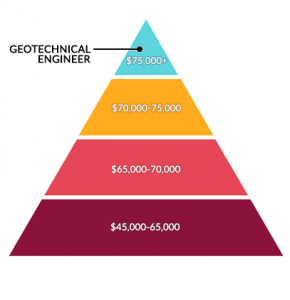Getting My Geotheta To Work
Getting My Geotheta To Work
Blog Article
10 Simple Techniques For Geotheta
Table of ContentsGet This Report on GeothetaLittle Known Facts About Geotheta.Geotheta for Dummies6 Simple Techniques For GeothetaThe smart Trick of Geotheta That Nobody is Talking About

They perform site investigations, collect examples, carry out research laboratory tests, and assess data to assess the viability of the ground for construction jobs - Geo Tech Engineering. Based upon their findings, geotechnical engineers provide recommendations for structure layout, slope stability, preserving frameworks, and mitigation of geotechnical threats. They work together with other professionals, such as engineers, architectural engineers, and building and construction teams, to guarantee that geotechnical considerations are incorporated into the total task style and application
By analyzing the actions and residential properties of dirt and rock, they can identify potential geotechnical threats such as landslides, soil negotiation, or incline instability. Their competence helps stop failings or crashes that can jeopardize lives and home. Below are some comprehensive obligations and responsibilities of a geotechnical engineer: Site Investigation: Geotechnical engineers conduct site investigations to collect information on subsurface conditions.
They analyze the information to comprehend the residential properties and behavior of the dirt and rock, including their stamina, leaks in the structure, compaction qualities, and groundwater conditions. Geotechnical Analysis and Style: Geotechnical designers evaluate the information accumulated throughout site investigations to assess the security and suitability of the website for construction projects. They execute geotechnical calculations and modeling to assess elements such as birthing capability, settlement, slope stability, side earth pressures, and groundwater flow.
An Unbiased View of Geotheta
Foundation Style: Geotechnical engineers play a crucial duty in designing structures that can securely sustain the desired structure. They analyze the dirt conditions and tons requirements to figure out the suitable structure kind, such as shallow foundations (e.g., footings), deep structures (e.g (https://www.awwwards.com/geotheta/)., stacks), or specialized techniques like soil improvement. They take into consideration aspects such as settlement restrictions, birthing capacity, and soil-structure interaction to establish optimum foundation designs
They evaluate construction strategies, screen site activities, and carry out field evaluations to validate that the design suggestions are complied with. If unforeseen geotechnical concerns emerge, they examine the situation and offer suggestions for removal or changes to the design. Threat Evaluation and Reduction: Geotechnical engineers examine geotechnical dangers and dangers connected with the project website, such as landslides, liquefaction, or soil erosion.

Collaboration and Interaction: Geotechnical engineers function carefully with other professionals involved in a job, such as designers, architectural designers, and construction teams. Reliable interaction and partnership are important to integrate geotechnical factors to consider right into the general task layout and building and construction procedure. Geotechnical designers offer technical experience, solution queries, and make sure that geotechnical requirements are met.
The smart Trick of Geotheta That Nobody is Talking About
Here are some types of geotechnical designers: Structure Engineer: Structure designers focus on creating and evaluating structures for structures. They analyze the dirt conditions, tons requirements, and site characteristics to identify the most proper foundation type and design, such as superficial structures, deep foundations, or specialized methods like stack foundations.
They assess the variables influencing slope stability, such as soil residential properties, groundwater conditions, and slope geometry, and create strategies to stop incline failures and reduce dangers. Earthquake Engineer: Quake designers concentrate on examining and creating structures to withstand seismic pressures. They analyze the seismic danger of a website, assess soil liquefaction potential, and develop seismic layout standards to make sure the safety and resilience of frameworks during earthquakes.
They do field testing, collect examples, and examine the collected information to characterize the dirt homes, geologic developments, and groundwater problems at a website. Geotechnical Instrumentation Designer: Geotechnical instrumentation engineers concentrate on monitoring and gauging the behavior of soil, rock, and structures. They install and keep instrumentation systems that monitor factors such as dirt settlement, groundwater degrees, incline activities, and structural variations to evaluate efficiency and give very early warnings of potential concerns.
Examine This Report about Geotheta
They carry out tests such as triaxial tests, combination tests, straight shear tests, and permeability examinations to collect Consulting Engineers information for geotechnical analysis and layout. Geosynthetics Designer: Geosynthetics designers concentrate on the design and application of geosynthetic materials, such as geotextiles, geogrids, and geomembranes. They utilize these products to enhance dirt stability, reinforce inclines, give water drainage remedies, and control disintegration.
They often tend to be investigative people, which suggests they're intellectual, reflective, and inquisitive. They are curious, methodical, logical, logical, and rational. Some of them are additionally social, suggesting they're kind, charitable, participating, individual, caring, helpful, empathetic, tactful, and pleasant - Consulting Engineer.
In the workplace atmosphere, geotechnical engineers make use of specialized software application tools to execute computations, create styles, and examine information. They prepare records, testimonial job specs, interact with customers and group members, and coordinate task tasks. The office setting offers a helpful environment for study, evaluation, and partnership with other specialists involved in the task.
5 Simple Techniques For Geotheta
They often go to project websites to carry out website examinations, evaluate geotechnical conditions, and collect data for analysis. These visits include taking a trip to various places, in some cases in remote or tough terrains. Geotechnical engineers might carry out dirt tasting, conduct tests, and display building activities to make sure that the geotechnical aspects of the task are being implemented correctly.
Geotechnical engineers additionally operate in specialized geotechnical labs. In these centers, they perform experiments, execute tests on dirt and rock examples, and analyze the engineering residential or commercial properties of the products. Geotechnical laboratory designers function thoroughly in these environments, handling testing devices, operating instruments, and tape-recording data. They work together with other laboratory staff to ensure precise and trusted screening outcomes.
Report this page